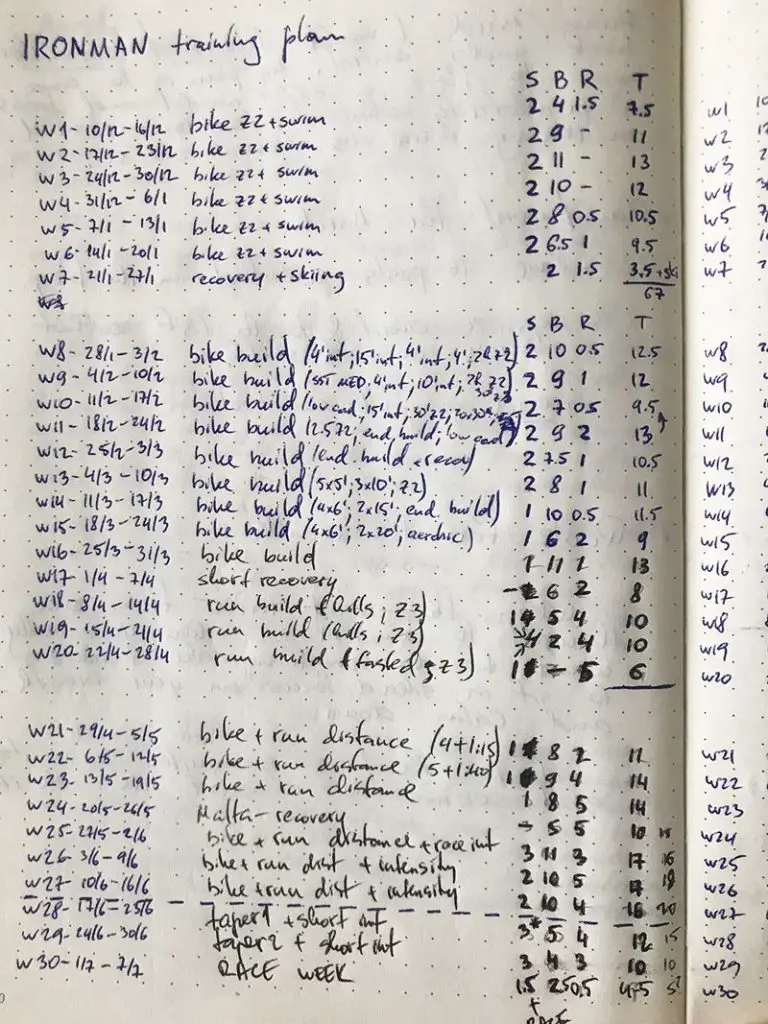5 Ways A Training Diary Helps Athletes Train And Perform Better
I started a training diary on the same day I got my first heart rate monitor. It was so exciting that I spent the whole evening after the training session creating a spreadsheet and manually putting in all possible metrics.
My watch didn’t even have a GPS function at the time. So, I had to check the map to record the distance and calculate the average speed.
That was back in 2006.
Now there are various dashboards and tools that link training data automatically, as well as produce reports and statistics. However, the habit I’ve developed carries more value than just a graph with weekly totals.
A simple practice of recording my progress forced me to frequently reflect on what was going well and what didn’t. Over time it improved the quality of my training sessions and kept me focused. Even at times when everything seemed to be going south.
What to put in a training diary?
Training diary is exactly what it sounds like. It’s a notebook (or a digital version of it) where athletes record their daily training progress. The reason why many don’t do it is because they don’t really know what should be recorded. And what’s the use of that.
After all, if training data is automatically synchronized through an app, there’s not much left to record, right?

Actually, speed, heart rate or anything a smartwatch tracks is not the most important information to athletes. There are more important factors to consider. For instance, what was the program for the session and how tough it felt? Is there any accumulated fatigue from previous sessions? What was the mental state and were there any troubling thoughts? What did an athlete eat and how did he sleep? And so on.
There are several ways how this simple practice is beneficial to athletes. Apart from being a great point of reference, this ‘trial & error’ database is a great tool for self-development as well.
#1 Training diary keeps athletes focused and motivated
Very often we don’t see much progress from day to day or even from week to week. That’s when it’s easy to fall into the ‘training, training, training’ mentality and forget the bigger goal.
What writing a diary does is force an athlete to take the time and put training progress into perspective. This helps to distance from the physical demand of training and reconnect with the sole purpose of it. Which is why logging down training progress is very powerful in combination with setting goals.
It’s, therefore, best to separate the diary into years and focus on 1-2 specific goals for the year.
Over time, athletes can see how strong or how fast they’ve got, compared to exactly where they’ve been a month or a year ago. These ‘small wins’ and milestones serve as stepping points to a bigger goal and give an extra motivation to continue.
#2 Reviewing training helps to notice patterns
Recording all possible data may not make sense at first, but after a while it will get increasingly more useful.
There are many factors impacting performance. In the moment it can get overwhelming trying to figure out what caused a bad training session or a ‘down week’. However, reviewing training logs after the session usually helps to identify what caused the problem.
It also allows to spot patterns, like bad sleep after too big of a dinner. Or feeling more energy after a day of easy Zone 1 training, etc. Fixing these small missteps optimizes the training process. Thomas Jefferson once said,
If you want something you’ve never had, you must be willing to do something you’ve never done.
That is very much relevant for athletes. Most are ready to train more and harder, but often doing more of the wrong thing does not move them in the right direction.
Doing something they’ve never done is what’s called a ‘deliberate practice’. It’s actively looking for what is not going right and trying something new to correct it. This learning mindset is essential to becoming a better athlete.

The Resilient Athlete
A Self-Coaching Guide to Next Level Performance in Sports & Life
Are you aiming to become a resilient athlete who is able to withstand any pressure? Be able to jump on any opportunity? Take any challenge life throws at you head on?
Then this book is for you.
Learn more#3 Self-reflection makes athletes more experienced
As much as a training diary helps to spot areas of improvements, it also works as a reference for good performances. For example, what led to a personal best in a race or a particularly good feeling on a training session.
Most of what athletes do gets repeated on a constant basis – training, recovery, racing, nutrition. Having notes to look back at to see what has worked well (i.e. warm up, nutrition, recovery, race strategy) is very helpful.
This reference allows the athlete to replicate good performance and avoid repeating a bad one. In other words, it’s athlete’s experience. And experience beats speed most of the time.
Training diary helped me a lot as I was preparing to run my first marathon and my first Ironman. Instead of hiring a coach I used my old training logs to see which training blocks made me faster, where I pushed too far or got sick and what might be relevant for an endurance race. From that I drafted a program to account for my strengths.
During the training process I recorded my progress and feelings and this self-analysis helped me to learn more about the physiology, training and nutritional aspects of endurance sports. All of that ultimately led to the creation of this blog.

#4 Training gets more tailored and training plans more accurate
The best part about knowing how the body responds to specific factors is the power it gives to influence the training process.
A training plan is only as good as its execution. It doesn’t make sense to follow the plan of an elite marathoner only to find yourself fatigued and skipping sessions in a couple of weeks.
Experienced athletes know exactly what works for them and, therefore, can focus on that. They tend to shift their training sessions to maximize recovery and get the maximum benefit.
Tailoring a plan in that way allows them to keep it optimized and avoid unnecessary fatigue. This way they can include more quality training sessions and, ultimately, get better results.
#5 Training diary is a good listener
Besides performance benefits, maintaining a consistent practice of noting down thoughts and feelings is very helpful for mental strength.
Writing down your emotions and feelings helps to recognize them and learn to control them. Over time it will make an athlete more resilient to various mental stimuli and allow to better focus on the things that matter.
Training diary should be a personal property. While some advise to share it with the coach, I think it’s best to keep the content to yourself and be very honest about your feelings and emotions. Once you’ve analyzed your results and came up with some conclusions, it makes sense to discuss them with a coach.
This way you’ll first do the hard work of self-awareness and then the coach will be able to guide you in the right direction.
Did you find this information useful? Share the post with others using the buttons below.
Have an opinion? Share via links below and tag @theathleteblog
Tags In
Andrejs
GET A FREE TRAINING PLAN
Subscribe to my email list and get access to a free 4-week “back in shape” training plan
You’ll also get two full-body strength sessions and some other goodies!

How did I get here?
Hey there! My name is Andrejs and I am here to inspire, entertain and get you fit for any adventure.
I went from being an over trained pro athlete to an endurance coach sharing how to listen to your body and live life to the fullest.
Traveling, new sports & activities brought new meaning to my training and made it much more effective, fun and enjoyable. And I'm here to help you do the same.


